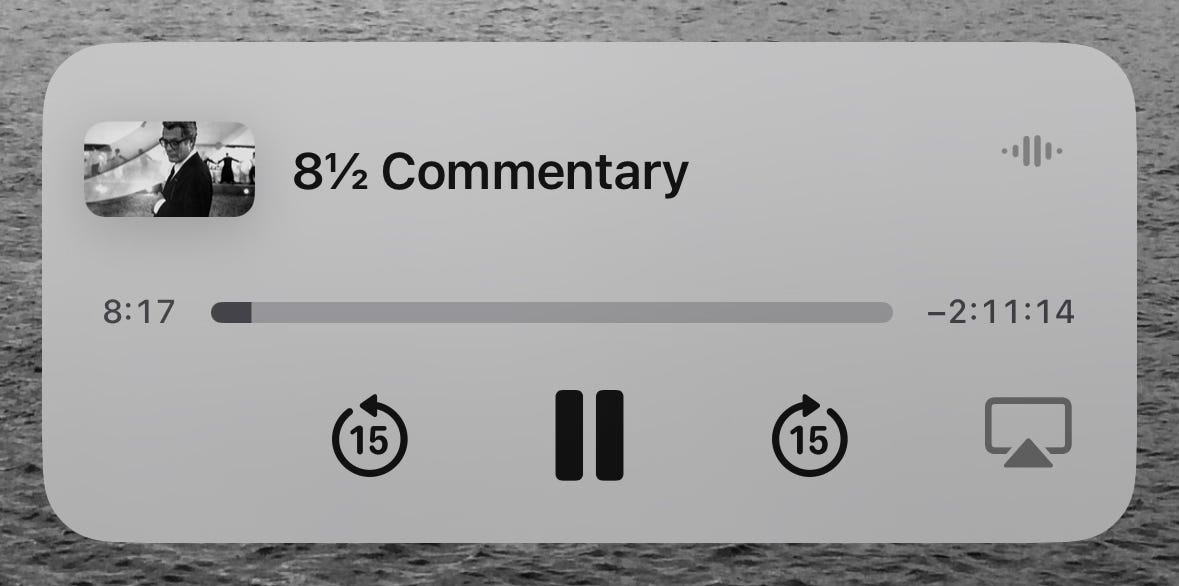Voices In My Head
A new use for commentary tracks
Discussed: DVD commentary tracks, podcasts, The Criterion Channel, physical media, A.V. Club columns
Last year I ran out of podcasts. I never thought it would happen. There’s usually a backlog of hundreds of hours of listening sitting in my Overcast queue. But between packing and cleaning my apartment for a move, driving solo halfway across the country, and trying to increase the distance of my daily jogs, I ate through my archive.
While I was looking around for new shows or audiobooks, I remembered something a friend had told me. Whenever he has housework to do, he pulls up a movie commentary track on the Criterion Channel app and lets it play while he does his chores.
As a budding cinephile in the DVD era, I have a nostalgic love for commentary tracks. Whenever I rented a new disc, I set aside time to watch the original movie then the commentary back-to-back. Even though I’d seen every episode of The Simpsons (of the good seasons, anyway) multiple times, I pre-ordered each new season’s DVD box set so I could watch with narration from the writers and directors. I spent hours in front of the TV learning the specific language of these tracks—the cliches, the insights, the character archetypes like the sarcastic writer, chummy scene partners, and detail-obsessed director. I followed the A.V. Club’s “Commentary Tracks of the Damned” column so I could laugh at the tropes and cliches of commentaries. I also learned how my favorite movies and shows were made on a technical and personal level. On the best commentaries, examinations of technique are punctuated by gossipy behind-the-scenes anecdotes.
As streaming and the demands of a career took over, I stopped following commentaries. I forgot they existed, and was only reminded of them when a fellow movie obsessive would cite a fact that could only have come from a DVD commentary. Had I thought about it at the time, I probably would’ve said commentary tracks had died (save for the comedic RiffTrax, which turned any movie into a Mystery Science Theater 3000 episode). Commentaries were effectively dead for me anyway, since I didn’t have a DVD player to watch them on. I did have a smartphone, though, and I soundtracked my daily routines with podcasts about movies. I listened to dry shows about film theory, jokey shows about bad movies, and all manner of programs focused on specific genres of movies or ways of viewing. These held me over for years. But finding myself out of new episodes last year, I decided to go back to commentaries.
The Criterion Channel was my first stop. Criterion invented the commentary track with the 1984 laserdisc of King Kong and it’s the only streaming service that routinely posts commentaries for streaming. The app allows audio to play while the screen is locked, too, so I could listen just as I would a podcast. I cooked a holiday meal while listening to the commentary on Salesmen. Later, I jogged through town listening to the commentary for Smithereens and Metropolitan. Sometimes it was disorienting hearing to a discussion that referred to visuals I didn’t have in front of me, but for movies I was familiar with, I didn’t find myself lost very often. The audio of the original movie is usually audible underneath the conversation, and I was surprised at how well I could pull up the scenes in my mind, recalling the framing, the acting, and everything else I love about the movie. And some commentaries work without the visual. The 8 1/2 commentary is a mix of essay and interview and plays like a (very arty) radio show.
After soundtracking my life with commentaries, I realized what I had been missing. Podcast hosts can be insightful in their expertise and entertaining in their style, but they generally aren’t insiders on a production. An analysis show, whether it’s a heady or jokey, works best when the hosts embrace their position as outsiders or comedians, or when their forays into history are backed up with evidence. I did some housecleaning with my movie podcast subscriptions, keeping the ones with the most engaging hosts, best-informed conversations (often made possible by staff researchers), or the funniest jokes and dropping the ones that don’t go beyond the group-of-friends-sounds-off structure.1 Effort can be a replacement for expertise, but some shows have neither. Those who do put in the effort sometimes go so far as to release watch-along episodes, where the hosts provide their own commentary tracks. These fall short as an audio-only experience. They have long stretches of silence punctuated by reactions with no context, and copyright laws block them from playing the audio of the movie underneath.
No one can listen to commentaries exclusively, though. Because they’re structured as accompaniments, not all commentaries work on their own. This fact becomes clear about twenty or so minutes in, when I scramble to open Overcast and find something else to fill my ears. I’m interested in what film scholars have to say about Tarkovsky’s Solaris, but it’s hard to stay focused on their thoughts while I’m navigating city streets or trying to convert cups to ounces in my head. Podcasts, at least, were made to be listened to this way. But my commentary excursion has reminded me what a valuable resource was lost in the jump to streaming.
The shows I kept include: You Must Remember This; Black Men Can’t Jump in Hollywood; Linoleum Knife; Hit Factory; The Flop House; and Blank Check.



